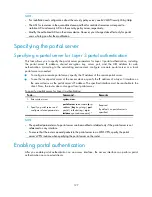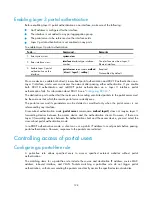
126
Configuration task list
Task Remarks
Specifying a portal server for Layer 3 portal authentication
Required
Enabling Layer 3 portal authentication
Required
Controlling access of portal
users
Configuring a portal-free rule
Optional
Configuring an authentication source subnet
Setting the maximum number of online portal
users
Specifying the authentication domain for portal
users
Configuring RADIUS related
attributes
Specifying NAS-Port-Type for an interface
Optional
Specifying a NAS ID profile for an interface
Specifying the source IP address for outgoing portal packets
Optional
Configuring portal stateful failover
Optional
Specifying auto redirection URL for authenticated portal users
Optional
Configuring portal detection
functions
Configuring online Layer 3 portal user detection
Optional
Configuring the portal server detection function
Configuring portal user information
synchronization
Optional
Configuration prerequisites
The portal feature provides a solution for user identity authentication and security check. However, the
portal feature cannot implement this solution by itself. RADIUS authentication needs to be configured on
the access device to cooperate with the portal feature to complete user authentication.
The prerequisites for portal authentication configuration are as follows:
•
The portal server and the RADIUS server have been installed and configured properly. Local portal
authentication requires no independent portal server to be installed.
•
With re-DHCP authentication, the IP address check function of the DHCP relay agent is enabled on
the access device, and the DHCP server is installed and configured properly.
•
The portal client, access device, and servers can reach each other.
•
With RADIUS authentication, usernames and passwords of the users are configured on the RADIUS
server, and the RADIUS client configurations are performed on the access device. For information
about RADIUS client configuration, see "
."
•
To implement extended portal functions, install and configure iMC EAD, and make sure that the
ACLs configured on the access device correspond to those specified for the resources in the
quarantined area and for the restricted resources on the security policy server. For information
about security policy server configuration on the access device, see "
."
















































